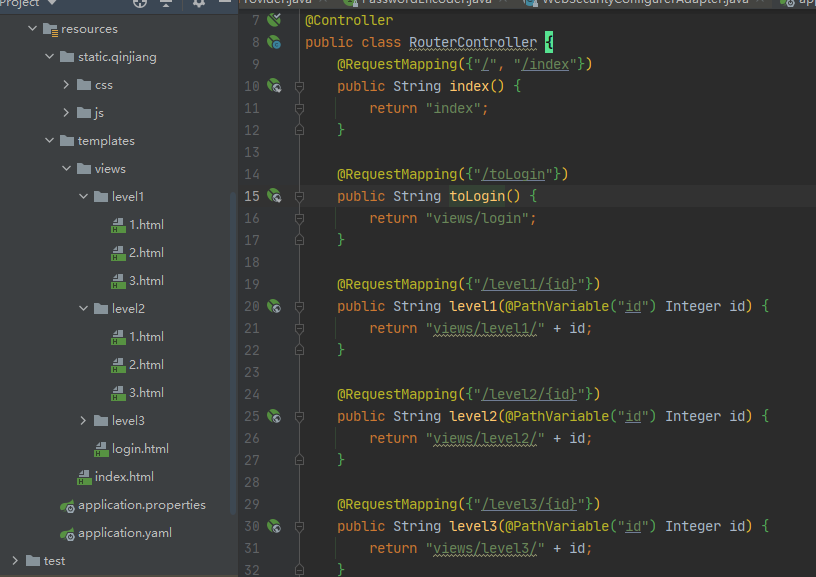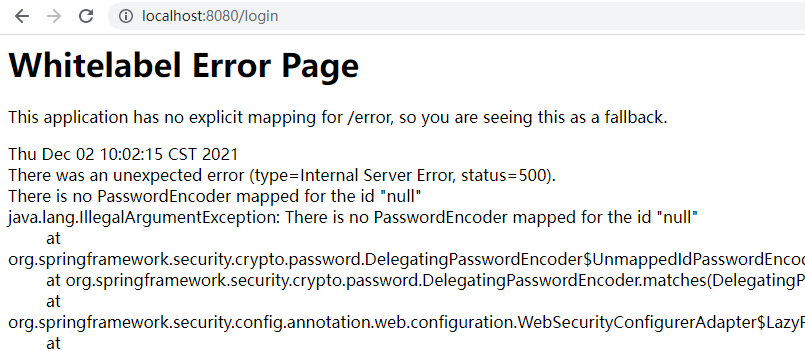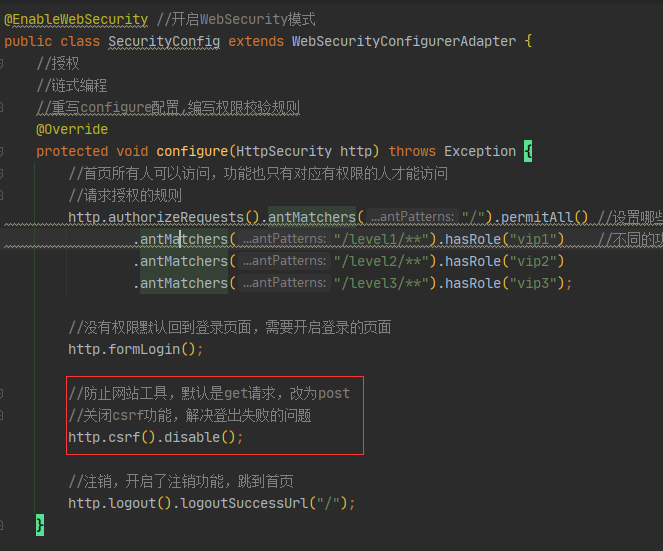1.概要
SpringSecurity 基于 Spring 框架,提供了一套 Web 应用安全性的完整解决方案。
正如你可能知道的关于安全方面的两个主要区域是“认证”和“授权”(或者访问控制),一般来说,Web 应用的安全性包括用户认证(Authentication)和用户授权(Authorization)和攻击防范 三个部分,这两点也是 Spring Security 重要核心功能。
(1)用户认证指的是:验证某个用户是否为系统中的合法主体,也就是说用户能否访问该系统。用户认证一般要求用户提供用户名和密码。系统通过校验用户名和密码来完成认证过程。通俗点说就是系统认为用户是否能登录
(2)用户授权指的是验证某个用户是否有权限执行某个操作。在一个系统中,不同用户所具有的权限是不同的。比如对一个文件来说,有的用户只能进行读取,而有的用户可以进行修改。一般来说,系统会为不同的用户分配不同的角色,而每个角色则对应一系列的权限。通俗点讲就是系统判断用户是否有权限去做某些事情。
(3)攻击防范(防止伪造身份)
其核心就是一组过滤器链,项目启动后将会自动配置。最核心的就是 Basic Authentication Filter 用来认证用户的身份,一个在spring security中一种过滤器处理一种认证方式。
记住几个类:
-
WebSecurityConfigurerAdapter: 自定义Security策略
-
AuthenticationManagerBuider: 自定义认证策略
-
@EnableWebSecurity: 开启WebSecurity模式
2.入门项目
准备工作
首先引入pom依赖
<!--security--> <dependency> <groupId>org.springframework.boot</groupId> <artifactId>spring-boot-starter-security</artifactId> </dependency> <dependency> <groupId>org.springframework.boot</groupId> <artifactId>spring-boot-starter-thymeleaf</artifactId> </dependency> <dependency> <groupId>org.thymeleaf.extras</groupId> <artifactId>thymeleaf-extras-java8time</artifactId> </dependency>
导入静态资源,可以从 https://www.kuangstudy.com/app/code 下载,springSecurity素材,github有免费的,我找不到了

写RouteController进行页面跳转
package com.kuang.controller; import org.springframework.stereotype.Controller; import org.springframework.web.bind.annotation.PathVariable; import org.springframework.web.bind.annotation.RequestMapping; @Controller public class RouterController { @RequestMapping({"/", "/index"}) public String index() { return "index"; } @RequestMapping({"/toLogin"}) public String toLogin() { return "views/login"; } @RequestMapping({"/level1/{id}"}) public String level1(@PathVariable("id") Integer id) { return "views/level1/" + id; } @RequestMapping({"/level2/{id}"}) public String level2(@PathVariable("id") Integer id) { return "views/level2/" + id; } @RequestMapping({"/level3/{id}"}) public String level3(@PathVariable("id") Integer id) { return "views/level3/" + id; } }
页面很简单

编写SpringSecurityConfig配制文件
package com.kuang.config; import org.springframework.security.config.annotation.authentication.builders.AuthenticationManagerBuilder; import org.springframework.security.config.annotation.web.builders.HttpSecurity; import org.springframework.security.config.annotation.web.configuration.EnableWebSecurity; import org.springframework.security.config.annotation.web.configuration.WebSecurityConfigurerAdapter; import org.springframework.security.crypto.bcrypt.BCryptPasswordEncoder; @EnableWebSecurity //开启WebSecurity模式 public class SecurityConfig extends WebSecurityConfigurerAdapter { //授权 //链式编程 //重写configure配置,编写权限校验规则 @Override protected void configure(HttpSecurity http) throws Exception { //首页所有人可以访问,功能也只有对应有权限的人才能访问 //请求授权的规则 http.authorizeRequests().antMatchers("/").permitAll() //设置哪些路径可以直接访问,不需要认证 .antMatchers("/level1/**").hasRole("vip1") //不同的功能也只有对应有权限的人才能访问 .antMatchers("/level2/**").hasRole("vip2") .antMatchers("/level3/**").hasRole("vip3"); //没有权限默认回到登录页面,需要开启登录的页面 http.formLogin(); //开启了注销功能 http.logout().logoutSuccessUrl("/"); } //认证 //密码编码:PasswordEncoder //在spring Security 5.0+ 新增了很多的加密方法 //重写configure配置,将我们自己的校验密码器注入到该bean中 @Override protected void configure(AuthenticationManagerBuilder auth) throws Exception { //这些数据正常应该从数据库中读 auth.inMemoryAuthentication().passwordEncoder(new BCryptPasswordEncoder()) .withUser("yangyang").password(new BCryptPasswordEncoder().encode("123")).roles("vip2", "vip3") .and() .withUser("root").password(new BCryptPasswordEncoder().encode("123")).roles("vip1", "vip2", "vip3") .and() .withUser("guest").password(new BCryptPasswordEncoder().encode("123")).roles("vip1"); } }
WebSecurityConfig类使用了@EnableWebSecurity注解 ,以启用Spring Security的Web安全支持,并提供Spring MVC集成。它还扩展了WebSecurityConfigurerAdapter,并覆盖了一些方法来设置Web安全配置的一些细节。
密码加密使用的类是:PasswordEncoder,需要将它进行实例化,使用BCryptPasswordEncoder实例化,并放入spring容器中
权限规则的修改类是:继承WebSecurityConfigurerAdapter,并重写里面的configure(HttpSecurity http)方法
configure(HttpSecurity)方法定义了哪些URL路径应该被保护,哪些不应该。也就是说,设置那些路径可以直接访问,不需要认证
如果设置密码,没有 new BCryptPasswordEncoder().encode("123"),会出现以下错误

thymeleaf认证功能
导入依赖:
<!--security-thymeleaf整合包--> <dependency> <groupId>org.thymeleaf.extras</groupId> <artifactId>thymeleaf-extras-springsecurity5</artifactId> <version>3.0.4.RELEASE</version> </dependency>
在index.html中导入命名空间
xmlns:sec="http://www.thymeleaf.org/thymeleaf-extras-springsecurity4"
我在pom依赖中引入的是5版本的,在命名空间导入的是4版本的,我导入5版本的不管用,不知道为什么
重点:
sec:authorize="isAuthenticated()" : 是否认证登录!来显示不同的页面
修改导航栏,增加认证判断
<!--登录注销--> <div class="right menu"> <!--如果未登录,只显示登录--> <div sec:authorize="!isAuthenticated()"> <a class="item" th:href="@{/toLogin}"> <i class="address card icon"></i> 登录 </a> </div> <!--如果已登录,显示用户名和角色权限--> <div sec:authorize="isAuthenticated()"> <a class="item"> 用户名:<span sec:authentication="principal.username"></span> 角色权限:<span sec:authentication="principal.authorities"></span> </a> </div> <!--如果已登录,显示注销--> <div sec:authorize="isAuthenticated()"> <a class="item" th:href="@{/logout}"> <i class="sign-out icon"></i> 注销 </a> </div> </div>
如果有vipx的权限便显示
<div class="column" sec:authorize="hasRole('vip1')"> <div class="ui raised segment"> <div class="ui"> <div class="content"> <h5 class="content">Level 1</h5> <hr> <div><a th:href="@{/level1/1}"><i class="bullhorn icon"></i> Level-1-1</a></div> <div><a th:href="@{/level1/2}"><i class="bullhorn icon"></i> Level-1-2</a></div> <div><a th:href="@{/level1/3}"><i class="bullhorn icon"></i> Level-1-3</a></div> </div> </div> </div> </div> <div class="column" sec:authorize="hasRole('vip2')"> <div class="ui raised segment"> <div class="ui"> <div class="content"> <h5 class="content">Level 2</h5> <hr> <div><a th:href="@{/level2/1}"><i class="bullhorn icon"></i> Level-2-1</a></div> <div><a th:href="@{/level2/2}"><i class="bullhorn icon"></i> Level-2-2</a></div> <div><a th:href="@{/level2/3}"><i class="bullhorn icon"></i> Level-2-3</a></div> </div> </div> </div> </div> <div class="column" sec:authorize="hasRole('vip3')"> <div class="ui raised segment"> <div class="ui"> <div class="content"> <h5 class="content">Level 3</h5> <hr> <div><a th:href="@{/level3/1}"><i class="bullhorn icon"></i> Level-3-1</a></div> <div><a th:href="@{/level3/2}"><i class="bullhorn icon"></i> Level-3-2</a></div> <div><a th:href="@{/level3/3}"><i class="bullhorn icon"></i> Level-3-3</a></div> </div> </div> </div> </div>
如果注销404了,就是因为它默认防止csrf跨站请求伪造,因为会产生安全问题,我们可以将请求改为post表单提交,或者在spring security中关闭csrf功能;在 SecurityConfig配置中增加 http.csrf().disable();

定制登录页面
1.在index.html中,设置自定义的login请求,指向toLogin
<!--如果未登录,只显示登录--> <div sec:authorize="!isAuthenticated()"> <a class="item" th:href="@{/toLogin}"> <i class="address card icon"></i> 登录 </a> </div>
2.在login.html中,添加记住我,并指向表单提交的url
<form th:action="@{/login}" method="post"> <div class="field"> <label>Username</label> <div class="ui left icon input"> <input type="text" placeholder="Username" name="user"> <i class="user icon"></i> </div> </div> <div class="field"> <label>Password</label> <div class="ui left icon input"> <input type="password" name="pwd"> <i class="lock icon"></i> </div> </div> <div class="field"> <input type="checkbox" name="remember"> 记住我 </div> <input type="submit" class="ui blue submit button"/> </form>
注意:此处的name为自定义的user,而不是username,所以要在配置文件中设置username和password
3.后端代码
package com.kuang.config; import org.springframework.security.config.annotation.authentication.builders.AuthenticationManagerBuilder; import org.springframework.security.config.annotation.web.builders.HttpSecurity; import org.springframework.security.config.annotation.web.configuration.EnableWebSecurity; import org.springframework.security.config.annotation.web.configuration.WebSecurityConfigurerAdapter; import org.springframework.security.crypto.bcrypt.BCryptPasswordEncoder; @EnableWebSecurity //开启WebSecurity模式 public class SecurityConfig extends WebSecurityConfigurerAdapter { //授权 //链式编程 //重写configure配置,编写权限校验规则 @Override protected void configure(HttpSecurity http) throws Exception { //首页所有人可以访问,功能也只有对应有权限的人才能访问 //请求授权的规则 http.authorizeRequests().antMatchers("/").permitAll() //设置哪些路径可以直接访问,不需要认证 .antMatchers("/level1/**").hasRole("vip1") //不同的功能也只有对应有权限的人才能访问 .antMatchers("/level2/**").hasRole("vip2") .antMatchers("/level3/**").hasRole("vip3"); //没有权限默认回到登录页面,需要开启登录的页面 //定制登录页 http.formLogin() .loginPage("/toLogin") //指定loginPage,对应index.html登录的url .usernameParameter("user") //设置username的参数,对应login.html自定义的username .passwordParameter("pwd") .loginProcessingUrl("/login"); //登录表单提交请求 //防止网站工具,默认是get请求,改为post //关闭csrf功能,解决登出失败的问题 http.csrf().disable(); //注销,开启了注销功能,跳到首页 http.logout().logoutSuccessUrl("/"); //开启记住我功能 cookie,默认保存两周,自定义接受前端的参数 http.rememberMe().rememberMeParameter("remember"); } //认证 //密码编码:PasswordEncoder //在spring Security 5.0+ 新增了很多的加密方法 //重写configure配置,将我们自己的校验密码器注入到该bean中 @Override protected void configure(AuthenticationManagerBuilder auth) throws Exception { //这些数据正常应该从数据库中读 auth.inMemoryAuthentication().passwordEncoder(new BCryptPasswordEncoder()) .withUser("yangyang").password(new BCryptPasswordEncoder().encode("123")).roles("vip2", "vip3") .and() .withUser("root").password(new BCryptPasswordEncoder().encode("123")).roles("vip1", "vip2", "vip3") .and() .withUser("guest").password(new BCryptPasswordEncoder().encode("123")).roles("vip1"); } }